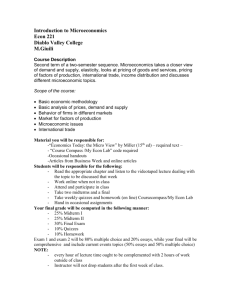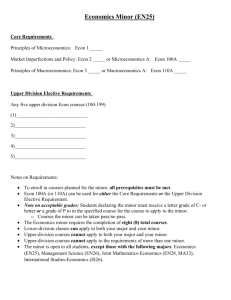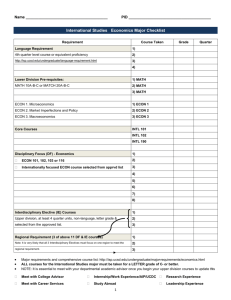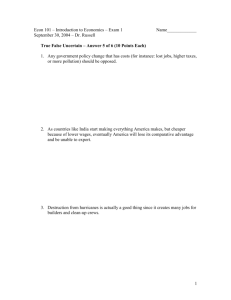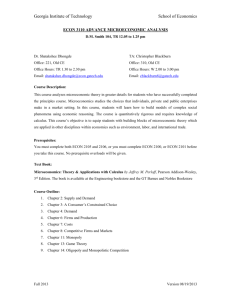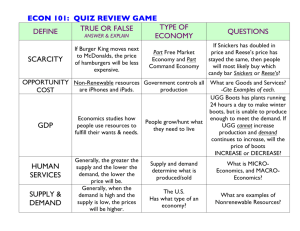Externalities
advertisement
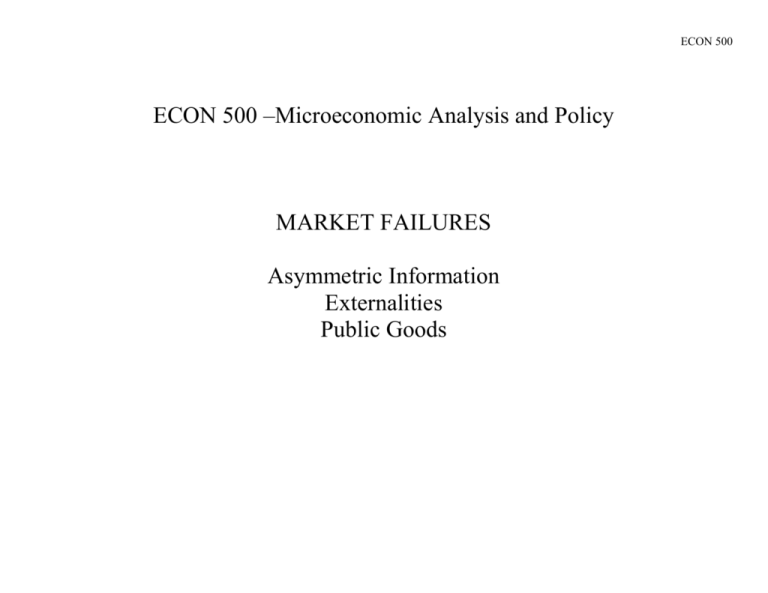
ECON 500
ECON 500 –Microeconomic Analysis and Policy
MARKET FAILURES
Asymmetric Information
Externalities
Public Goods
ECON 500
Markets can and do fail to achieve the efficiency and welfare ideals
that we have presented thus far.
Asymmetric Information prevents the execution of simple efficient
contracts between economic agents and leads to moral hazard and
adverse selection problems.
Externalities where actions of one economic agent affects the well-being
of another agent in a way that is not priced through the market system
leads to misallocation of resources.
Public goods, because of their nonexclusivity and nonrivalry, cannot be
efficiently provisioned through the market system because of free rider
problem.
ECON 500
Asymmetric Information
Markets may not be fully efficient in the presence of asymmetric
information when one side has information that the other side does not.
Market for insurance
Market for credit
Market for used cars
Market for labor
Similar problems also arise when one party to the transaction cannot
monitor the actions of the other party that directly affects her well-being
Manager-worker relationship
CEO compensation
Insurance
ECON 500
ECON 500
Contracts with more complex terms than simple per-unit prices may be
needed to help solve problems raised by such asymmetric information.
In a full-information environment, the principal could propose a contract
to the agent that maximizes their joint surplus and captures all of this
surplus for herself, leaving the agent with just enough surplus to make him
indifferent between signing the contract or not.
This outcome is called the first best, and the contract implementing this
outcome is called the first-best contract.
The outcome that maximizes the principal’s surplus subject to the
constraint that the principal is less well informed than the agent is called
the second best, and the contract that implements this outcome is called
the second-best contract.
ECON 500
ECON 500
Hidden Action Model – Moral Hazard
Imagine a firm with one representative owner and one manager
Suppose the gross profit of the firm is
where e is manager’s effort and ε is a normally distributed random
variable with mean 0 and variance σ2 that affects gross profit and
represents shocks outside of the manager’s control.
Manager’s disutility of exerting effort c(e) is increasing and convex, i.e.,
c’(e) > 0 , c’’(e) > 0
Owners profit is the difference between gross profit and manager’s salary
ECON 500
Hidden Action Model – Moral Hazard
Risk neutral owner wants to maximize expected net profit
Risk averse manager’s utility derived from her salary with constant
absolute risk aversion parameter A is
U(s) = -e-As- c(e)
Manager maximizes the expected utility of from her salary
ECON 500
Optimal Salary Contract – First Best with Observable Effort:
The owner pays the manager a fixed salary s* if she exerts the first-best
level of effort e* and nothing otherwise.
For the manager to accept the contract, her expected utility must exceed
what she would obtain from his next-best job offer (assumed to be 0)
The lowest salary that satisfies this participation constraint is
Owner’s profit is
which is maximized at the effort level satisfying
ECON 500
Optimal Salary Contract – Second Best with Unobservable Effort:
When salary cannot be conditioned on effort, with a constant salary s, the
manager’s expected utility would equals s – c(e), which is maximized by
choosing the lowest level of effort possible: e=0
Suppose the owner offers a salary that is linear in gross profit:
The constant a can be interpreted as the base salary and b can be thought
of as the incentive pay.
We can analyze the relationship in three stages; the owner decides on
a and b, the manager accepts or rejects the contract, and the manager
decides on the level of effort.
ECON 500
Optimal Salary Contract – Second Best with Unobservable Effort:
Manager’s expected utility from the linear salary is
Manager will choose the level of effort that satisfies (IC)
In the second stage, manager will accept the contract if (IR or PC)
The owner can utilize the base salary to induce the manager to accept the
contract, and use the incentive pay to induce her to exert the right effort.
ECON 500
Optimal Salary Contract – Second Best with Unobservable Effort:
In the first stage owner chooses a and b to maximize his expected surplus
subject to the incentive compatibility and individual rationality constraints
since both constraints will hold with equality, owner maximizes:
Therefore the second best level of effort satisfies
ECON 500
Optimal Salary Contract – Second Best with Unobservable Effort:
The optimal effort in the second best case is less than the first best effort
e** < e*
When the owner cannot specify e in a contract, then he can induce effort
only by tying the manager’s pay to firm profit.
However, doing so introduces variation into manager’s pay for which the
risk-averse manager must be paid a risk premium and this risk premium
adds to the owner’s cost of inducing effort.
The fundamental tradeoff that appears in the presence of asymmetric
information is between incentives and risk. As the manager becomes more
risk averse, or as the variance of profit increases, the owner will need to
reduce the dependence of manager’s salary on gross profit which will in
turn reduce her effort.
ECON 500
Hidden Type Model – Adverse Selection
Suppose a consumer of type θ: { θH , θL } obtains the surplus
when she consumes q units of a good and pay a fixed tariff T.
Her marginal benefit is decreasing in q and she can be of high type with
probability β.
Suppose the monopolist’s profit is
Π = T-cq
ECON 500
First Best Pricing with Observable Types
Setting the consumer’s outside option to 0, she will participate if
Monopolist will then set the tariff as high as possible
Monopolist’s profit becomes:
and is maximized at the quantity
First best pricing offers each type consumer a quantity qH , qL that
maximizes their surplus, and extracts that surplus with an appropriate
tariff TH TL.
ECON 500
First Best Pricing with Observable Types
ECON 500
Second Best Pricing with Unobservable Types
If types are unobservable, the Monopolist cannot prevent high types from
obtaining the contract intended for low types.
In order to prevent this adverse selection, the tariff charged to high types
needs to be reduced, and furthermore, the contract for the low types need
to be distorted and made less desirable for high types.
The second best contract is constructed by ensuring that both types
participate voluntarily, and they obtain the contract intended for them. In
other words, the monopoly should offer a menu of contracts that makes it
undesirable for high types to pretend to be low types.
ECON 500
Second Best Pricing with Unobservable Types
The monopolist’s maximizes:
subject to
Note that only the first and the last constraints are binding
ECON 500
Second Best Pricing with Unobservable Types
Using the binding constraints to solve for the tariffs we have:
Monopolist’s problem becomes an unconstrained maximization of
with the FOCs:
ECON 500
Second Best Pricing with Unobservable Types
ECON 500
Externalities
Effects of an economic actor’s actions on others
in ways that are not reflected in market transactions.
Interfirm Externalities:
Suppose that the production of some good y depends not only on inputs
but also on the production level of some other good x.
As long as the cross partial with respect to x is different than zero
externalities will be present.
ECON 500
Externalities
Effects of an economic actor’s actions on others
in ways that are not reflected in market transactions.
Externalities in Utility:
Suppose that the utility function of some economic agent S depends not
only on his consumption but also on the utility level of some other
consumer J
As long as the cross partial with respect to UJ is different than zero
externalities will be present.
ECON 500
Externalities is General Equilibrium
The utility function of a representative consumer in an economy is
Consumer has initial stocks of x and y (denoted by x* and y*) and can
either consume these (xc , yc) or use them as intermediary goods (xi , yi)
Good x is produced according to
Good x is produced according to
with g1 > 0 and g2 < 0 and
ECON 500
Externalities is General Equilibrium
The Lagrangean of the society’s utility maximization is
with the FOCs:
ECON 500
Externalities is General Equilibrium
Optimality in production requires
and
If the firms do not take externality into account more x is produced than
the level that is optimal for the society.
ECON 500
ECON 500
Solutions to the Externality Problem
Pigovian Tax:
If firms are found to be disregarding the externality, a per unit tax
that is precisely equal to the marginal harm that x causes to y production
would restore the optimality condition
ECON 500
Solutions to the Externality Problem
Tradable Pollution Rights
Firm y decides on how many rights to sell to firm x by maximizing
The FOC implies that the price for the pollution right will be
ECON 500
Solutions to the Externality Problem
Tradable Pollution Rights
If firm x has the right to pollute, it’s gross profits are:
Firm y’s gross profits are
This profit maximization will yield the same solution as the case where
firm y owns the rights.
ECON 500
Coase Theorem: As long as private property rights are well defined under
zero transaction cost, regardless of their initial assignment, exchange will
eliminate externalities and lead to efficient use of resources.
Public Goods
A good is a (pure) public good if, once produced, no one can be excluded
from benefiting from its availability and if the good is nonrival, i.e., the
marginal cost of an additional consumer is zero.
ECON 500
